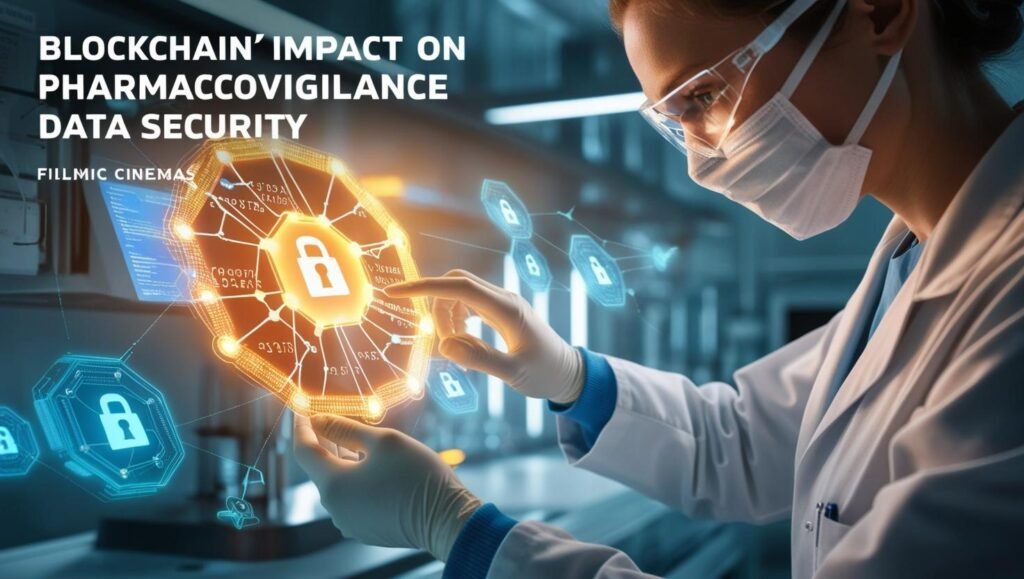In today’s fast-paced healthcare world, data security is crucial, especially for sensitive information like pharmacovigilance data. This is where blockchain technology steps in as a game-changer. Blockchain offers a secure and transparent way to manage data, making it an excellent fit for pharmacovigilance. By using blockchain, healthcare organizations can ensure that their data is protected against unauthorized access and tampering. This revolutionary approach not only enhances data security but also boosts trust in healthcare systems.
Pharmacovigilance Data Management

Pharmacovigilance might sound like a mouthful, but it’s actually a simple yet vital part of healthcare. At its core, pharmacovigilance is all about monitoring the effects of medical drugs after they’ve hit the market. Why is this important? Well, once a medicine is available to the public, it’s crucial to gather data on its safety and effectiveness over time. This data helps healthcare professionals ensure that the benefits of a drug continue to outweigh any risks. Think of pharmacovigilance as a safety net for patients, working to protect millions of individuals from any adverse effects that might arise from medications.
Without pharmacovigilance, we’d be in the dark about how drugs affect different populations across the globe. The effectiveness of drugs can differ due to factors like age, genetics, and even diet. Thus, continuous monitoring is crucial to adapt the usage guidelines if needed. This process aids in safeguarding public health, boosting confidence in health care systems, and maintaining trust in pharmaceuticals.
Current Challenges in Data Management
Now, pharmacovigilance is wonderful and all, but it doesn’t come without its fair share of challenges, particularly when it comes to data management. The process requires handling vast amounts of data from various sources, like clinical trials, healthcare providers, and reports from patients themselves. As you can imagine, things can get a bit chaotic.

One prime challenge is ensuring data consistency and accuracy. Each data point needs to be reliable because decisions affecting patient safety rest upon this information. Another hurdle is the integration of data from disparate systems and formats, which often don’t play well together. Ensuring patient privacy and complying with regulations like GDPR and HIPAA adds an additional layer of complexity.
What about the sheer volume of data? With mountains of incoming information, organizations must figure out efficient ways to store and manage data without breaking the bank. This is no small feat and requires harnessing cutting-edge technologies and infrastructure.
The Need for Secure Data Handling Solutions
With all these challenges in mind, it’s easy to see why secure data handling solutions are critical in pharmacovigilance. Imagine sensitive patient data falling into the wrong hands because of a security breach. The consequences could be disastrous, potentially compromising patient confidentiality and having serious legal and financial repercussions for healthcare companies.
Given data’s pivotal role in patient safety and regulatory compliance, having robust security measures is non-negotiable. Ensuring that the data isn’t tampered with or altered is essential in making accurate assessments of a drug’s safety profile. Moreover, as the volume of data continues to grow, there’s a pressing need for scalable solutions capable of managing these vast datasets effectively without compromising security.
Blockchain Technology

Fundamental Concepts of Blockchain
So, what exactly is blockchain? In layman’s terms, blockchain is a digital ledger that records transactions across many computers so that the recorded transactions cannot be altered retroactively. It’s like an incorruptible digital notebook that everyone can see, but nobody can change without agreement from the whole group.
Blockchains are composed of blocks, each containing a batch of transaction data. These blocks are linked together chronologically to form a chain, where each block references the previous one. The system is decentralized, meaning there is no central point of control or single database think of it as a shared document that everyone has a copy of.
The true magic lies in its transparency and immutability. Once a transaction is recorded in a block and added to the chain, it is virtually impossible to alter without modifying all subsequent blocks a prohibitively difficult task given the distributed nature and the consensus required from participants.
How Blockchain Differs from Traditional Databases

Traditional databases and blockchain might seem similar, as they both store data. However, they operate quite differently. A traditional database is typically centralized, which means a single entity manages it. Picture a library where only the librarian has the keys. It works well, but the librarian must be trusted entirely.
In contrast, blockchain is decentralized. There isn’t a “librarian,” but rather, everyone in the network holds a copy and can validate the “books” added to the “library.” This decentralization enhances reliability, as the failure of any single part won’t disrupt the entire database.
Traditional databases are designed for quick read and write operations, while blockchains are not as fast. However, blockchain shines in its ability to offer enhanced security, transparency, and trust, stemming from its immutable nature.
Advantages of Using Blockchain in Data Management

Now, let’s dive into why blockchain is making waves in the field of data management, especially in areas as crucial as pharmacovigilance. Here’s what makes it a game-changer:
– Immutability: Once data is written on a blockchain, it cannot be altered or deleted. This feature is vital for ensuring the integrity of pharmacovigilance data, providing a transparent audit trail.
– Decentralization: By distributing data across a network rather than storing it in a single location, blockchain significantly reduces the risk of data breaches.
– Enhanced Security: Blockchain employs advanced cryptographic techniques to secure data. This makes it resilient against hacking attempts, a crucial consideration in protecting sensitive patient information.
– Transparency and Traceability: Every addition or modification to the blockchain is timestamped and publicly visible, fostering a trustworthy environment where data can be verified independently by all stakeholders.
– Cost-Effectiveness: With blockchain, there’s no need for intermediaries, which typically translates to lower costs in data management processes.
– Efficiency and Speed: Despite being slower at processing compared to traditional databases, blockchain can expedite the reconciliation of data and eliminate redundancies. In the context of pharmacovigilance, this can greatly enhance the speed of data sharing and partnership among healthcare institutions and regulatory bodies.
In essence, integrating blockchain into pharmacovigilance data management has the potential not only to surmount many current challenges but also to pave the way for a more secure, efficient, and reliable healthcare system. As we forge ahead, embracing this technology could very well be the key to fortifying public health and trust in medical advancements.
Blockchain’s Impact on Pharmacovigilance Data Security

Pharmacovigilance is the science of detecting, assessing, and preventing adverse effects associated with pharmaceutical products. As you can imagine, managing such sensitive data is crucial, and that’s where blockchain technology steps in like a superhero. Its impact on pharmacovigilance data security is transformative and multifaceted.
Enhanced Data Integrity and Immutability
Let’s start with the basics: data integrity and immutability. Simply put, data stored on a blockchain is like writing with a permanent marker it’s there to stay! Each piece of information is encrypted and stored as a block, which is then linked to the previous one, creating a secure chain of data.
– Tamper-proof Records: Once data is added to the blockchain, it’s practically impossible to alter without being detected. This immutability ensures that pharmacovigilance data remains trustworthy and intact.
– Reliable Source of Truth: With its cryptographic nature, blockchain technology helps maintain a single, unalterable version of the truth, reducing the potential for discrepancies or clerical errors.
This level of data integrity is vital for regulatory compliance and scientific research, providing healthcare professionals with a reliable foundation for monitoring drug safety.
Improved Transparency and Traceability
The transparency of blockchain is one of its most appealing features. Each transaction or data entry on a blockchain is visible to all authorized participants, which can be a game-changer in pharmacovigilance.
– Audit Trail: Imagine being able to trace each adverse drug reaction report back to its source with complete visibility. Blockchain ensures that every update is tracked and auditable.
– Cross-Organization Collaboration: Pharmaceutical companies, regulators, and healthcare providers can all access the same up-to-date data without compromising confidentiality.
The transparency offered by blockchain not only builds trust among stakeholders but also enables quicker reaction times to potential safety issues, ensuring that patients receive timely and effective care.
Robust Access Control and Privacy Protection
Privacy and access control are always top of mind when dealing with sensitive medical data. Blockchain stands out by providing a fine balance between accessibility and confidentiality.
– Permissioned Blockchain Networks: These networks restrict data visibility to authorized users only, ensuring that personal patient data remains confidential.
– User-Defined Access: Using smart contracts, rights and permissions can be determined and enforced automatically, allowing only specific stakeholders to view or modify data.
By implementing robust access control measures, blockchain technology offers a secure framework that respects patient privacy while keeping data accessible to those who need it.
Case Studies and Real-World Applications

The theory behind blockchain in pharmacovigilance sounds promising, but let’s explore how it’s being applied in the real world. Pharmaceutical companies and healthcare institutions are actively exploring and implementing blockchain solutions to enhance data management and security.
Leading Pharmaceutical Companies Adopting Blockchain
Several leading pharmaceutical companies have been quick to see the potential of blockchain and are pioneering its use in pharmacovigilance.
– Pfizer and Boehringer Ingelheim: These giants have been exploring blockchain to streamline data sharing across clinical trials, improving data accuracy and speeding up the drug development process.
– Novartis: By collaborating with tech companies, Novartis is using blockchain for serialization and tracking of drugs within its supply chain, ensuring safety and compliance in pharmacovigilance data.
These initiatives reflect a growing industry trend toward adopting innovative technology to enhance safety and security across healthcare operations.
Successful Pilot Projects in Pharmacovigilance
Beyond the big players, several pilot projects have shown how blockchain can revolutionize pharmacovigilance.
– MediLedger Project: Developed by Chronicled, this blockchain-based network focuses on improving the tracking of pharmaceuticals, reducing the risk of counterfeit drugs while maintaining stringent pharmacovigilance checks.
– Guardtime: In collaboration with the Estonian government, Guardtime has implemented blockchain for e-health records, including detailed tracking of medication usage and adverse effects.
These case studies illustrate how various sectors within healthcare are marrying technology and medicine to secure and streamline processes for better patient outcomes.
Lessons Learned and Best Practices
As with any new technology, blockchain adoption comes with its set of challenges and learning curves. However, these implementations have also offered valuable lessons and best practices.
– Collaborative Approach: Successful blockchain projects often involve cross-industry collaboration. Pharma companies, tech firms, and regulators working together provide well-rounded, effective solutions.
– Scalability Considerations: It’s important to plan for scalability from the outset. Ensuring that the system can handle increasing volumes of data without compromising speed or security is critical.
– Regulatory Alignment: Hardware and software solutions should be aligned with national and international regulatory standards to ensure seamless integration and compliance.
By focusing on these best practices, companies can harness blockchain to its full potential, turning pharmacovigilance data management into a robust, secure, and transparent process.
In conclusion, blockchain technology is not just a buzzword in the realm of data security; it’s a groundbreaking tool reshaping how we manage and protect pharmacovigilance data. With its promise of enhanced integrity, transparency, and access control, blockchain is set to become an integral part of healthcare technology. By learning from real-world applications and embracing innovative practices, the healthcare industry can advance towards safer and more efficient pharmacovigilance, ultimately benefiting patient safety and public health.



